Windows Update serves as a platform for new updates to Windows. It helps to ensure that your computer is running with the latest features and security updates. But recently some users reported experiencing error code 0x8024401c when running the Windows Update on their computer.
Your Windows 11/10 computer might receive this error for a number of reasons. One of the most common reasons is that your computer doesn’t have a working internet connection. In this post, we will show you how to fix Windows Update Error Code 0x8024401c so you can update your computer again.
This error is accompanied by the following message:
There were some problems installing updates, but we’ll try again later. If you keep seeing this and want to search the web or contact support for information, this may help (0x8024401c)
What do Windows Updates do?
Windows Update keeps various Microsoft programs up-to-date, including Windows itself. It includes security patches and feature enhancements to protect Windows from malware attacks and others. The Windows Update service also allows you to view the update history, which displays all the updates that have been downloaded and installed on the computer.
Windows Update Error Code 0x8024401c for WSUS
There are some solutions that require you to make changes to the system registry. Therefore, we recommend creating a system restore point before you proceed. This will help you roll back your Windows if anything goes wrong. To fix Windows Update Error code 0x80244o1c, use the following suggestions:
- Run Windows Update troubleshooter
- Modify the Registry Editor
- Change the Network Settings
- Run System File Checker
- Perform a clean boot
Let’s now see them in detail:
1] Run Windows Update troubleshooter
There are various types of troubleshooters built into Windows, which are useful for fixing different types of problems. Running the Windows Update troubleshooter is your first step when you encounter a Windows Update error. To do so, follow these steps:
- Use the Windows+I keyboard shortcut to open the Settings app
- Select the System tab from the left pane.
- Then scroll down and click on Troubleshoot section.
- On the next page, click Run next to the Windows Update option
- This might solve your problem once the troubleshooting process is complete.
2] Modify the Registry Editor
In order to fix 0x8024401c on your computer, you can modify the settings in Registry Editor. But be careful while modifying the registry editor as incorrectly editing your registry may severely damage your system. In case you are not very good at editing the registry, ask someone for assistance or skip this method and try another one. If you want to continue, the steps are as follows:
- Open the Registry Editor.
- Navigate to the following key – \WindowsUpdate\AU
- In the right pane, locate and double click on UseWUServer.
- Change the Value data 0 and click on the OK button.
- Now close the Registry Editor and restart your PC.
Here is a more detailed explanation of the above process:
To get it started, you will first need to open the Registry Editor. For this, click on the Start button, type Registry Editor, and press Enter.
When the User Account Control window prompts on your screen, click on the Yes button to give your approval.
In the Registry Editor window, navigate to the path:
HKEY_LOCAL_MACHINE\SOFTWARE\Policies\Microsoft\Windows\WindowsUpdate\AU
Alternatively, you can copy the above path and paste it into the Registry Editor’s address bar.
Select the AU folder and then move to the right pane.
In the right pane, look for the registry file called UseWUServer.
Once you find it, double click on it for modification. If it is not available there, create a new 32-bit DWORD value, and name it UseWUServer.
After that, set the value data 0 and then click on the OK button to apply the changes.
Now close the window and restart your computer.
3] Change the Network Settings
Users reported that when they switched the network connection, the problem got fixed. Here are the steps you can use to do so:
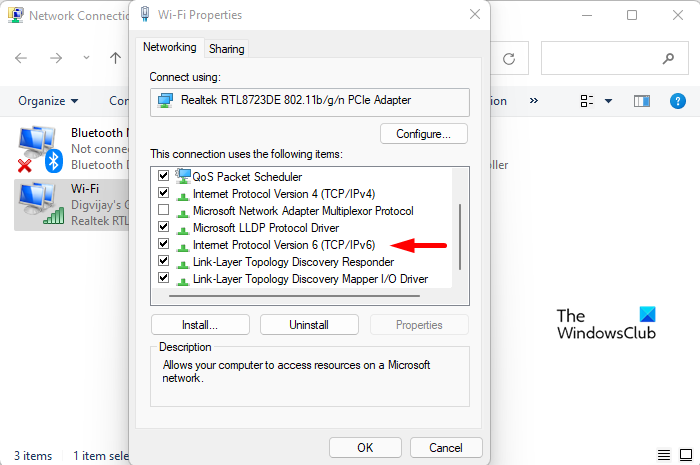
- Open the Windows Settings.
- Select Network & internet from the left pane.
- Scroll down to the bottom and click on Advanced network settings.
- Under the Related settings section, click on More network adapter options.
- Right-click the connection to which you are currently connected, and then select Properties.
- On the Networking tab, uncheck the option stating Internet Protocol Version 6 (TCP/IPv6).
- Then click on the OK button to save the changes.
Now restart your Windows and check if it resolved the problem.
4] Run System File Checker
System File Checker (SFC) is a Windows tool that users can use to scan system files for corruption and restore them if needed. There is a possibility that some of the files that are necessary for Windows Update are damaged, modified, or missing. If you have missing or corrupt system files, you need to use System File Checker and then the Deployment Image Servicing and Management (DISM) tool to restore them.
To run the SFC and DISM, follow the below suggestions:
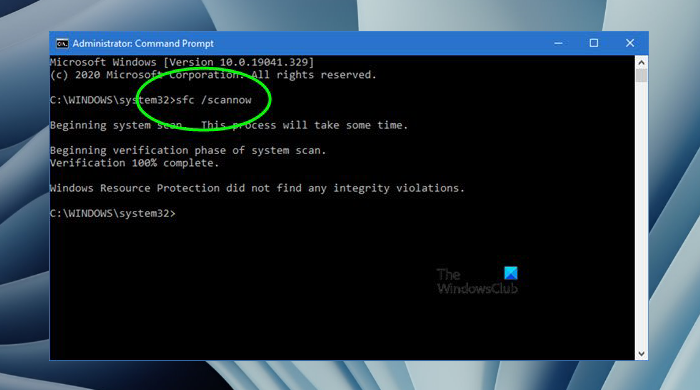
- Now type in the command sfc /scannow and then hit Enter.
- The procedure will take a few minutes to complete. Therefore, as long as the text code is scanned by the system, you are free to perform any other tasks.
- Once the SFC scan is complete, restart your computer and see if it works.
- Restart your computer and see if the issue is solved now. When that does not resolve the issue, run the DISM tool to repair the corrupted files.
- In the elevated Command Prompt window, copy and paste the following command:
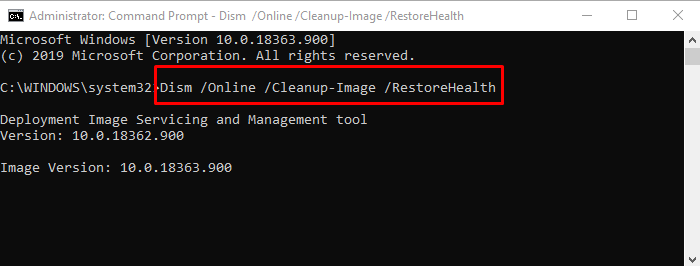
DISM.exe /Online /Cleanup-image /Restorehealth
- Start your computer again and the error should be resolved.
5] Troubleshoot in Clean Boot State
There are times when Windows Update issues are actually caused by third-party applications. This problem can be resolved by troubleshooting your computer in a clean boot state in which only the most essential files and services are loaded. This procedure is as follows:
- Right-click on Start and select Run from the menu.
- Type MSConfig in the search box and press Enter.
- In the System Configuration window, navigate to the Services tab.
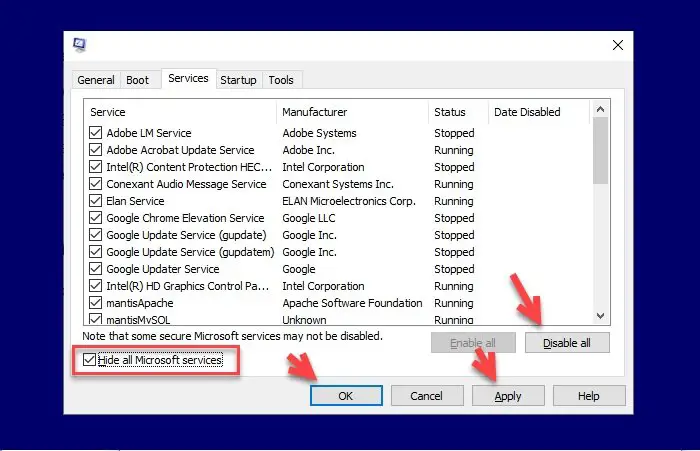
- Check the box next to Hide all Microsoft services and click Disable all.
- Click OK to save the changes.
- You should now go to the Startup tab and click the Open Task Manager link.
- Make sure the Startup tab is selected in the Task Manager window.
- After selecting each startup service, click Disable to stop them.
- Now restart your computer and see if the problem has been resolved.
- After that, you need to launch the System Configuration tool.
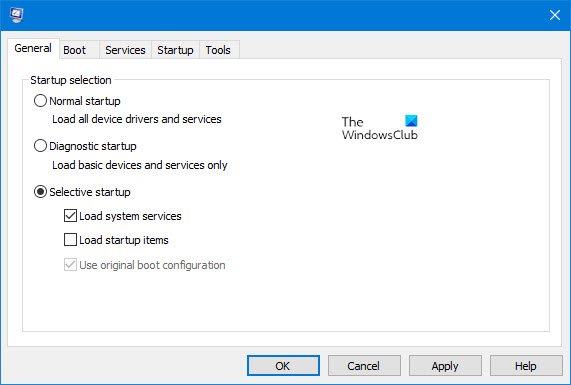
- Go to the General tab, select the Load system services checkbox.
- Press Apply > OK to save your changes and restart the computer.
- After the problem is resolved, you can enable the services one at a time.
How can I fix errors with Windows Update?
There might be a number of causes that can lead to Windows Update errors. Sometimes, WiFi issues and fluctuating signals can also result in Windows Update errors. If you encounter a Windows Update error, here are some general methods you can use.
When should Windows Update components be reset?
Windows Update components play a crucial role in the operation of Windows Update. If these components get corrupted, you may encounter different types of errors while trying to update Windows. If this situation occurs, Windows Update errors can be corrected by resetting the Windows Update components.